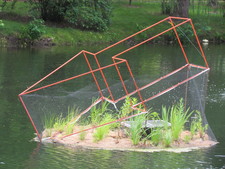Science and Art: Working Together for Water Quality
Lake LaVerne has been a fixture on the campus of Iowa State University since 1916, complete with its own campus legend: if you and your sweetheart can walk all the way around the lake in silence three times, you will always be together.
Unfortunately, the water in the lake is not always as lovely as the legend associated with it. Like other Iowa bodies of water, Lake LaVerne suffers from algae blooms that turn the lake green and murky. Austin Stewart, ISU Professor of Art, says, “Many students are aware that Lake LaVerne is not as healthy as it could be, but are unaware of the chemical processes that lead to the algal blooms.” Stewart, along with two other faculty members and a small team of students, set out to address the blooms in a way that not only fixed the problem, but also made people think.
Inspired by the floating gardens of Lake Xochimilco in Mexico City, the team began to design and build VFIs – Vegetated Floating Islands. By May of 2015, three islands were installed in Lake LaVerne. Vegetated Floating Islands act like a hydroponic system. Instead of soil, the roots hunt in the water for nutrients. The design of the island increases the surface area of the aquatic vegetation, allowing for greater nutrient uptake.
The Lake LaVerne floating islands are not just science, but also art! Each VFI features a metal sculpture of an arrow pointing down the slope of the island and into the water. The art installation reminds the viewer that the water flows downwards, picking up pollutants as it follows the contours of the land. To Stewart and team, it wasn’t enough to simply clean up the lake. They wanted to start a conversation.
“Art and science are highly interrelated,” says Stewart. “Though differing in methodology, both are avenues of inquiry for learning more about ourselves and our world.”
In the fall, the islands will be removed from the lake so they can be tested to see how much impact they made on the water quality. But their broader purpose has already shown signs of success. Since installing the islands, Stewart says, “We have overheard and been involved in several conversations about nonpoint source pollution and the impact that high levels of nutrients have on aquatic ecosystems.” Stewart adds, “The number of people taking time to read the informational signs posted around the lake has been far greater than we anticipated, which is wonderful.”

